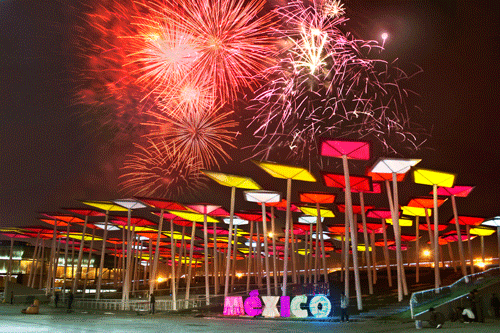|
|


ADVERTISEMENT
Buy Your own advertising
spaces!
.
Download Adobe Acrobat Reader to open [PDF] files.
Recent Visitors
Viva Mexico! Mexico's Pavilion, People, and 'Papalotes'
2010. 25 June
 The Mexico Pavilion at night with its signature kite-like formations extending from the grassy hill at the 2010 Shanghai Expo. [Provided by Mexican Pavilion]
The Mexico Pavilion at night with its signature kite-like formations extending from the grassy hill at the 2010 Shanghai Expo. [Provided by Mexican Pavilion]
(english.cri.cn)
The Mexico Pavilion at the Shanghai Expo aims not only to highlight some of the nation's most precious original cultural artifacts, but also a colorful and vivacious culture known for its friendly and impassioned people.
Mexico conjures up images of beaches, mariachis, tacos and pi?atas, but the Mexico Pavilion also aims to show a side of one of Latin America's Spanish-speaking country that also is proud of its ancient indigenous Aztec and Mayan culture.
Ana Garcia, Director of the Mexico Pavilion, says they aim to show that Mexico is a country that also created pyramids and whose capital city was home to Frida Kahlo, one of the country's most beloved female artists.
The Mexico Pavilion's exterior features kite structures stretching up out of the green hill of the Expo surface. Garcia explains that the kite is an image chosen purposely for its connection to Chinese culture and society.
The architecture for the pavilion came in the form of a national contest two years ago, with about 1,500 total participants submitting around 60 team projects.
Garcia says the kites signify a link between Mexico and China because Chinese traders introduced it centuries ago when they arrived in the Americas.
The word in Spanish, "papalote," means butterfly and is derived from the Nahuatle word "papalotl."
The pavilion uses the Expo's theme "Better City, Better Life" to portray Mexico in three rooms called "City and Nature," "City and People" and "City and Heritage."
One of the more interesting exhibits of "City and People" gives visitors a chance to see the world through Mexican eyes in some of the nation's most culturally relevant cities like Queretaro, Guanajuato, Morelia and Mexico City. The room is filled with 40 beautifully designed traditional Mexican masks, each depicting everyday life in the country through the eyes of its inhabitants.
Many of the pavilions at the Expo have used ancient history and culture as a way to reach out to the Chinese. The Mexico Pavilion offers a stone tablet depicting carved images of Mayans. The artifact comes directly from Chichen Itza, one of the Mayan wonders of the Yucatan peninsula, which dates back to around 600 AD.
One of the more impressionable exhibits is the "Altar to the Virgin of Dolores," which dates to about 1690 and represents the dominant Spanish influence after the conquest, which left a deep-seeded Roman Catholic presence in Mexico.
Garcia says that the response from the Chinese has varied greatly since the piece represents an interior of a classical Roman Catholic church and may appear slightly morbid to those unfamiliar with it.
One of the other prized items on display is by Frida Kahlo, a Mexican painter of the 20th century whose self-portrait graces the wall by the exit. The pavilion seeks to show a modern Mexico capable of exuding artistic creativity.
Garcia says the pavilion seeks to show Mexico to the Chinese, because many people don't know much about the country. She says while some Chinese may already be acquainted with European countries such as Italy and France from restaurants in large Chinese cities that feature their cuisines, they usually are not familiar with Mexican food.
That may be why the restaurant at the Mexico Pavilion is quite a hit with visitors, offering them tasty dishes such as quesadillas, chilaquiles and tacos with frozen margaritas and cold Corona beer.
Other cultural activities on offer at the pavilion include Mexican dances and sometimes mariachi bands whose musicians are famous for their ornately embroidered, black and white suits, Mexican sombreros and lively songs.
For a true lesson in Mexican culture, this month the pavilion is hosting 2010 World Cup parties whenever the home team plays. During the games, visitors can marvel at the staff's boisterous enthusiasm and bright green jerseys.
Mexican volunteer Daniela Cabrera says that what matters is neither the artifacts nor the money spent at the pavilion, because the main treasure is actually the spirited culture of the people who work there.
Source: english.cri.cn


